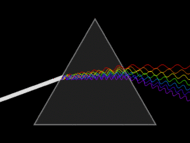Physics:Dyakonov–Voigt wave

A Dyakonov–Voigt wave (also known as DV wave and Dyakonov–Voigt surface wave) is a distinctive type of surface electromagnetic light wave that results from a particular manipulation of crystals. It was discovered in 2019 by researchers from the University of Edinburgh and Pennsylvania State University and its unique properties were described based on models involving equations developed in the mid-1800s by mathematician and physicist James Clerk Maxwell.[1][2][3][4][5] Its discoverers found that the wave is produced at the specific interface between natural or synthetic crystals and another material, such as water or oil.[2][3] Such DV waves were found to travel in a single direction, and decay as they moved away from the interface.[2] Other types of such surface waves, like Dyakonov surface waves (DSWs), travel in multiple directions, and decay more quickly.[3] DV waves decay as "the product of a linear and an exponential function of the distance from the interface in the anisotropic medium," but the fields of the Dyakonov surface waves decay "only exponentially in the anisotropic medium".[1] Research co-leader Tom Mackay noted: "Dyakonov–Voigt waves represent a step forward in our understanding of how light interacts with complex materials, and offer opportunities for a range of technological advancements."[2] Applications of the newly found waves may include biosensor improvements for blood sample screening, and fiber optic circuit developments, to permit a better transfer of data.[2][3]
This wave is now classified as an exceptional surface wave.[6][7]
See also
References
- ↑ 1.0 1.1 Mackay, Tom G.; Zhou, Chenzhang; and Lakhtakia, Akhlesh (28 August 2019). "Dyakonov–Voigt surface waves". Proceedings of the Royal Society A 475 (2228). doi:10.1098/rspa.2019.0317. PMID 31534431. Bibcode: 2019RSPSA.47590317M.
- ↑ 2.0 2.1 2.2 2.3 2.4 University of Edinburgh (3 September 2019). "Eminent scientist's 160-year-old theories aid light wave discovery". Phys.org. https://phys.org/news/2019-09-eminent-scientist-year-old-theories-aid.html. Retrieved 4 September 2019.
- ↑ 3.0 3.1 3.2 3.3 "New Type of Electromagnetic Wave Discovered - An international team of scientists from the United Kingdom and the United States has discovered a previously unknown type of electromagnetic wave: a Dyakonov-Voigt surface wave." (in en-US). 4 September 2019. http://www.sci-news.com/physics/dyakonov-voigt-surface-wave-07561.html.
- ↑ Weldon, Victoria (4 September 2019). "19th-century Scottish physicist linked to new discovery". Herald Scotland. https://www.heraldscotland.com/news/17878290.19th-century-scottish-physicist-linked-new-discovery/. Retrieved 4 September 2019.
- ↑ Hanks, Micah (4 September 2019). "From Beyond the Grave, James Clerk Maxwell Helped These Researchers See Things in a "New Light"". GralienReport.com. https://www.gralienreport.com/physics/from-beyond-the-grave-james-clerk-maxwell-helped-these-researchers-see-things-in-a-new-light/. Retrieved 5 September 2019.
- ↑ Lakhtakia, Akhlesh; Mackay, Tom G.; and Zhou, Chenzhang (2021). "Electromagnetic surface waves at exceptional points". Eur. J. Phys. 42: 015302. doi:10.1088/1361-6404/abb6c7.
- ↑ Lakhtakia, Akhlesh; and Mackay, Tom G. (2020). "From unexceptional to doubly exceptional surface waves". J. Opt. Soc. Am. B 37 (8): 2444. doi:10.1364/JOSAB.399403. Bibcode: 2020JOSAB..37.2444L.
 |

